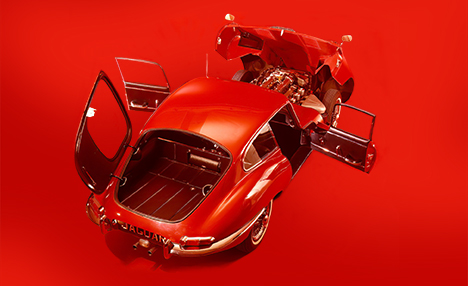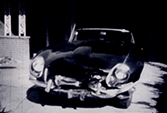Interview with Roger Menadue, Conclave ’93
In 1939, a friend of mine who was with Armstrong Whitworth, the aircraft manufacturer encouraged me to go and work in their plant. I had always been interested in aviation and it seemed an ideal position. However when the war broke out in September we were ‘frozen’ in our occupations and couldn’t change jobs so there I stayed with AAV until the end of the war working on Whiteleys and Albemarles (for whom MG made the nose sections!). After a while I was transferred to a small grass aerodrome outside Leamington Spa where damaged aircraft were flown in for us to repair and put back into operational service.
Donald Healey meanwhile had married his wife Ivy and was at Triumph where they were making Hobson air craft carburetors, he then moved to Humber where he worked on their famous scout military vehicles and he stayed there until he quit and at the same time I joined him to form the Healey motor company in 1945. We used to work evenings and weekends on the projects we had discussed during the war and we were using a tin shed at Benfords, in Warwick who made concrete mixers where one of the directors was also a director of Triumphs. He let Donald have the shed inside the Benford facility to build his cars. Donald and I used to talk about building our own cars before the war but with Donald being tied to Triumph and the directors there not wishing to get into more radical sports car such as Donald proposed, Donald always felt restricted and wanted to go ahead with different designs, suspensions, engines, etc., to make a sports cat that was completely different. Donald was living in Kenilworth Road about two miles away from where I was living on a farm and we used to go down to the pub five times a week and talk plans for the future.
Wc built up a chassis and used to test that on the perimeter track of the local airfield Sunday mornings, loaded with weights, etc. during the week we’d modify the chassis, trying different coil springs or whatever. At this time we were using a Riley 2’/2 liter engine, we eventually got the chassis right and had an aluminum body built down at Westland’s at Hereford. Westlands were one of the largest aircraft manufacturers in England and well used to working in aluminum. I then drove the chassis down to Westlands one day with Donald following in his Sunbeam Alpine, which was his Humber company car for the next 3 weeks I stayed down in Hereford, getting the body onto the chassis which necessitated numerous adjustments, pedal clearances, routing the petrol pipes, etc. Jack Meddings of Lucas came down and together we saw to all the wiring for the lights, ignition etc and we brought the finished car back to Warwick in late 1945.
That was the first Westland Healey and we then went on to build the “Elliot” saloon or coupe, so called because the Reading based Elliot company did all the woodwork for this car. At this time Elliot’s was the premier wood working company in the U.K. and was actually, during this period, restoring all the wood panel work on the two queens, the “Queen Mary” and the “Queen Elizabeth”, ocean liners which had seen service as troop carriers during the war. We then took the car out to Jabbeke in Belgium where on the autobahn we performance tested it, incidentally we also took the first Austin-Healey out there to test. This had the Austin A90 four cylinder engine – a very similar engine in a way to the Riley, almost the same bore and stroke. The first body styled by Gerry Coker was built at Newport Pagnell by Tickford. I used to have to go down there and do the necessary adjustments installing stuff ad hoc as I had on the Westland.
After the 1952 motor show we were doing the Nash Healey, but at this time were only doing the chassis. Donald had made an arrangement with Farina that we would supply the chassis and engine which would then be shipped to Farina for body mounting. All these cars went to the United States because of the parity of the dollar, and the fact that we weren’t allowed to sell them on the home market! So we had nothing to sell at home. These cars had the Nash engine from America and English customs monitored very closely exactly how many engines came into the U.K and how many were exported – and the numbers had to match!
Donald then came up with the idea of using the Austin components which worked our much cheaper than using our own – we had our own suspension on the Elliots, the Silverstones, and the Westlands. This was rather an expensive way to go about it. as it was hand-made small quantity stuff. Once we had the Austin components, it became much less expensive and we could envisage making a sports car that would be available to the mass market. We were looking to make 10 cars per week, but after the motor show we began talking hundreds a week!
The British Motor Corporation at this time was developing plans to lay down a production line for the 100/4 at Longbridge, but in the meantime they asked us to build 25 cars a week at Warwick. Donald and the BMC people also drew up a program for the development of competition Healeys, and so I had twelve cars to build in my department and there were only two of us, Jock Reid and myself as we’d built the first car! Donald was always off somewhere; he disliked being in the production department and preferred traveling around the world promoting the cars. He couldn’t stand the humdrum same old day after day grind needed to produce the cars, which he called the sausage machine. BMC said they would finance our experimental shop and the racing program, so now I could bring in more staff who were technically qualified and also discreet, as we did not wish our “secrets” to be leaked to the competition! I used to insist that they did things my way and told them that while my way might seem a bit old fashioned, that they should humor me and we’d have a good working relationship!
BMC then cut the production program down to fifteen, and I was overseeing this program, while in addition, I also had another twelve cars which I had to build in my own shop. They also had me go over to Longbridge where Leonard Lord had given Harry Austin, the last of the Austin line, the job of supervising the Austin-Healey production line. Harry and I used to get together at the end of each day to compare notes on progress, and I remember well what he said one day: “I’m the last of the Austin family and I think I must have the best job in the world working with people like you. I couldn’t do half the things you do and make, and I couldn’t even get the drawings out of my own Austin people in time it’s taken you to develop this Healey. The unions would be on me like a ton of bricks!”
So we continued making more Healeys, 100-6’s, 3000s and now here we are at the largest gathering of Austin-Healeys in America which is a fitting tribute to Donald. He was a terrific chap to know but you never knew which way he would jump next. Also, he was a good engineer but mercurially impatient. He once said that he hadn’t the patience to do what I did. He was the accelerator and I was the brake because I always considered things through very carefully before embarking on a project or problem, and one of the nicest things he ever said was, “Rog, I don’t think the problem has been invented yet that you can’t solve eventually.” In all the 29 years we were together I never once asked for a raise or discussed money with Donald and I came out of the company earning roughly the equivalent of what I went in for. The people who had the Healeys to drive and made the money were the sales people, but Donald and I could certainly say we had the best of times together, in those early days of Austin-Healey. You got such a kick out of finding ways to do things, or solve a particular problem, and producing such a fine sports car. And do you know? At the end Donald hadn’t got a Healey, Geoff hadn’t got a Healey, and I didn’t have a Healey! And now we couldn’t afford one!







'One of the Men Behind the Big Healey' has no comments
Be the first to comment this post!